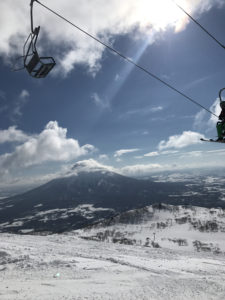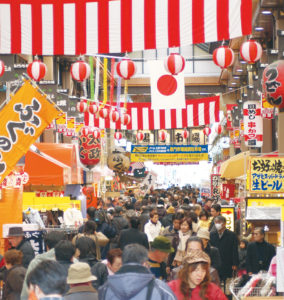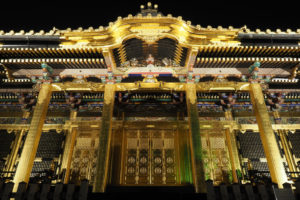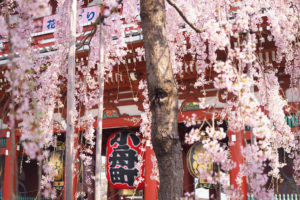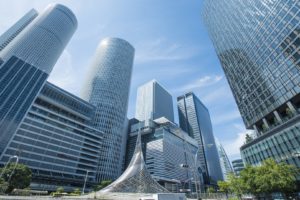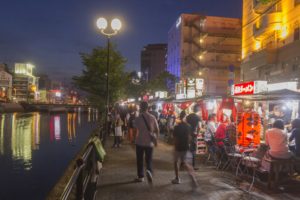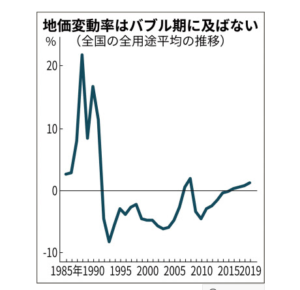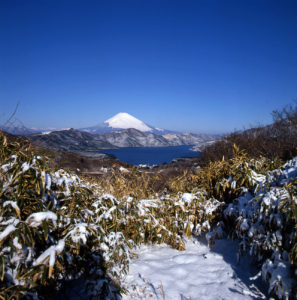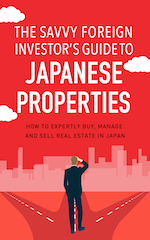(Niseko ski resort, Hokkaido)
Long-lasting growth ?
The Japanese government recently issued a report on the average land price in Japan.
It is announced every year and surveys 26,000 spots all over Japan.
Today I am sharing some key findings and forecast for the future.
Summary
Overall, the national average price for commercial land increased 2.8 percent and that of residential land edged up 0.6 percent.
The average price of all types of land in Japan’s regional areas (namely local areas) rose for the first time since 1992 last year
due to the influx of foreign tourists.
In regional areas outside the three major metropolitan areas of Tokyo, Osaka and Nagoya, the average price for land of all categories
including commercial, residential and industrial grew 0.4 percent from a year earlier.
However, land prices in depopulated areas continued to fall and average land price in regional areas at about 50 percent saw the price drop.
Regional residential land prices edged up 0.2 percent from a year earlier, marking the first rise in 27 years, while commercial land
prices went up 1.0 percent for the second straight year of increase.
(Kuromon-ichiba, Osaka)
The actual increase was very tiny but it is quite significant as it was the first rise in 27 years.
The prices in regional areas are showing a patchy picture.
Among the major regional cities, Fukuoka observed the largest increase in commercial land prices at 12.3 percent,
followed by Sendai at 10.7 percent, Sapporo at 8.8 percent, and Hiroshima at 5.8 percent.
(Let me remind you these increase is in ‘commercial lands’)
The three largest metropolitan areas (Tokyo, Osaka, Nagoya) saw an average growth of 5.1 percent in commercial
land prices and 1.0 percent in residential land prices, supported by increased demand for high rise condominiums and business offices.
The underlying reason is the historically low interest in Japan in which a number of banks are driving up the lending
to the real estate sector.
(Ueno To-sho-gu, Tokyo)
Japan introduced monetary easing in late 2012 as the first “arrow” of Abenomics, Prime Minister Shinzo Abe’s economic reform program,the policy has contributed to the creation of millions of jobs, according the government.
with a short-term interest rate of minus 0.1 percent and a 10-year government bond yield target of around zero percent —
the real estate industry would seem to be benefiting from BOJ’s expansionary monetary policy.
By prefecture, Okinawa tops the list in both commercial and residential land price gains, registering an increase of 10.3 percent and 8.5 percent, respectively.
By site (spot), surprisingly the town of Kutchan in northern Japan’s Hokkaido , a popular ski resort, ‘Niseko’ among foreign visitors,
led the nation in both commercial and residential land price jumps, shooting up 58.8 percent and 50.0 percent, respectively.
Three major economic zones
Now let’s look at the situation in the three major economic zones, Tokyo, Osaka, Nagoya and regional areas.
Tokyo metropolitan area
Price in Tokyo metropolitan commercial zones rose 4.7 percent,
The rise has been for six consecutive years.
Nearly 90% of the surveyed spots saw the rise.
In Tokyo, price of commercial zones in all 23 wards rose, and almost all 23 wards saw the rise over 5 per cent.
The price in Taito-ku (‘ku’ means ‘ward’) is particularly higher by 11 percent benefiting the increased number of foreign tourists
in Asakusa where demand for stores and hotels increased.
In the Tama area, the rate of increase for Musashino and Tachikawa exceeded 5per cent.
in saw Yokohama, Saitama and Chiba saw the rise of 3 to 4 percent.
In residential zones, prices were up 1.3 percent , increase for six consecutive years.
60 per cent of surveyed spots observed the price increase.
All 23 wards saw the rise , with an increase rate of more than 5 percent
(Asakusa, Tokyo)
Osaka
In commercial zones in Osaka, the area saw the rise of 6.4 percent.
the rate of increase has expanded from 4.7 percent, the previous year.
A total of 7 sites in Osaka Prefecture (4 sites) and Kyoto Prefecture (3 sites) came out at the top 10 list
for the rate of increase in commercial areas across the country.
The survey site in the Kuromon market (Kuromon Michiba) in Osaka City, which attracts many foreign tourists,
has a surprising 44.4 percent rise rate, ranking second in the country.
Kyoto City saw a high rate of increase in Higashiyama ward where many tourist spots are concentrated.
In residential zones, price rose 0.3 percent, and the rate of increase expanded from 0.1per cent over the previous year.
The rate of increase was biggest at 19.3% near the new station area of Kita Osaka Express in Minoh City, Osaka Prefecture.
(Takoyaki, Osaka)
Nagoya
In Nagoya commercial zones saw 4.7 percent rise YoY, outpacing 3.3 percent growth in the previous year.
Residential areas have also risen by 1.2 percent.
The commercial area near Nagoya Station is popular, which is expected to be redeveloped in anticipation of the opening of the Linear Chuo Shinkansen.
However, because the office supply around the same station is limited, land prices rise is noticeable even
in the further outskirt zones from center of Nagoya, such as Fushimi and Sakae district.
The Sakae area has a series of large-scale redevelopment plans, and competition with condominiums is also pushing up land prices.
In addition to Nagakute City, the rate of increase in Toyota City and Kariya City is high in residential areas in Aichi Prefecture.
There is strong demand on the back of the strong performance of the automotive industry.
It is said that in Ichinomiya City, there is a demand for apartments development around Nagoya Station that is as convenient as the central area.
(Mei-eki station, Nagoya)
Regional Areas (outside three major economic zones)
The price (all category) increased was observed in 33 percent of the total surveyed spots.
Average of commercial land price in all regional spots has risen by 1.0 percent, increase for two consecutive years.
Among the four major regional cities, Sapporo, in Sendai, Hiroshima, and Fukuoka, 96% of the sites saw the rise in price
The rate of increase in Fukuoka City was 12.3 percent in commercial zones, and that in Sendai City was 10.7 percent.
Average price of residential zones in all regional areas rose 0.2 percent, rising for the first time in 27 years.
30 percent of the spots saw the price rise.
(Yatai (food cart), Fukuoka)
Final thought
As I repeatedly say, overall price of the land is not in the bubble at all.
If you see the chart below, it is so clear that over all price is only gradually edging up.
(average land price change (%)) from Nikkei
However, as I mentioned above, some spots are souring and places like Niseko and Kuromon ichiba
are definitely in the bubble.
In fact, price of second-hand family size condominiums in central Tokyo has been dropping in a last few months.
The affordability is diminishing in deed.
Tokyo is always the early indicator in the real estate market of Japan and the market is sending the signal that the price has
gone up too quickly.
That said, the interest rate is still historical low level which should underpin the market by the reasonably boosted lending from banks.
And the institutional investors are making deals in the healthy manner.
(We need to remind ourselves that institutional investment is driving the market not the family size condos)
All in all, my take is the market will see a set back in short term and I will be vigilant.
If I have to bet, I will buy on decent dips.
Other Helpful Articles
Japan market update. How are big players betting ? : Is it in the state of bubble ?
(Mt. Fuji from Hakone)
Toshihiko Yamamoto
Real estate investing consultant and author.
Founder of Yamamoto Property Advisory in Tokyo.
International property Investment consultant and licensed
real estate broker (Japan).
He serves the foreign companies and individuals to buy and sell
the real estates in Japan as well as own homes.
He holds a Bachelor’s degree in Economics from
Osaka Prefecture University in Japan
and an MBA from Bond University in Australia
Toshihiko’s book, “The Savvy Foreign Investor’s Guide to Japanese Properties: How to Expertly Buy, Manage and Sell Real Estate in Japan”
is now out on Amazon, iBooks (iTunes, Apple) and Google Play.
About the book
Amazon.com Link
(Latest YouTube clip)

